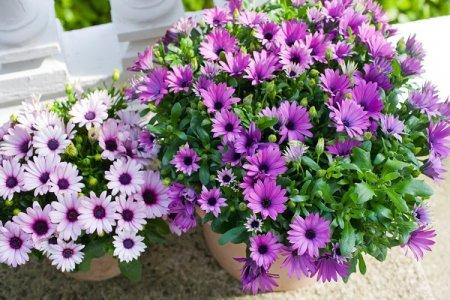
Perhaps this is the first time you hear the name catharanthus, but in fact it is just a pink periwinkle, a tropical guest of Madagascar, which has taken root on our windowsills or in the garden. True, now they have already been singled out as a separate genus, but the old name remains. Do you want to know more? Then read on!
general information
Catharanthus impress with their versatility and unpretentiousness. In the garden it is a wonderful seasonal annual, and in the room it is an amazing decoration of any apartment. Delicate flowers of 5 petals with a bright center are painted in all shades of pink.
In its natural environment, the catharanthus grows like a perennial, so it manages to grow up to 1.5 m.In our latitudes, it is much more compact - about 60 cm. It has been cultivated for several centuries, and during this time many decorative varieties have appeared.
A powerful root system allows the plant to survive in adverse conditions, but requires space. Dark leaves with light veins are very graceful and beautiful. The diameter of the flowers ranges on average from 3 to 5 mm.

Types of catharanthus
There are about 8 varieties of catharanthus, but only one is cultivated for decorative purposes - pink. On its basis, different varieties and hybrids were bred, and we have already figured out which of them are the most popular!
Aristocrat
This variety has very bright and large flowers up to 5 cm in diameter. This is a perennial that can be safely planted in the garden for the summer, and moved into the room for the winter.

Courage
Delicate pink and white colors instantly attract attention. This is a compact bush up to 30 cm, but it is very moisture-loving even by the standards of catharanthus.

Sicily
The bright pink flowers are so good that Sicily is one of the favorite varieties of breeders. And therefore, there are already dozens of sub-varieties that can be decomposed into a luxurious palette according to shades of petals.

Appleblossom
An elegant ampelous variety with long curly shoots was bred specifically to decorate balconies. It can also be grown on poles.

Titanium
Another ampelous variety with unusual red and fragrant flowers. With shoots up to 1 m long, the height of the bush rarely exceeds 15 cm, because they spread almost from the ground.

Caring for the catharanthus
Catharanthus almost does not cause trouble for flower growers, and caring for it differs little from caring for pelargonium or begonia. The main thing to remember is that after all, this is a tropical thermophilic plant!
Temperature
The most comfortable temperature for a catharanthus is above +22 degrees. He feels good even in the heat at +30. But the flower does not tolerate cold at all and dies already at +10 degrees. So in winter he definitely needs a warm room.

Lighting
Katarantus loves the sun and is not afraid of direct sunlight. Our latitudes are unlikely to surprise these indigenous inhabitants of Madagascar. But if the plant is outside the window, it is better to shade it slightly during peak hours, because the glass works like a lens.

Watering
Frequent or even daily watering is a must for an exotic guest. For abundant flowering, you cannot do without it and without spraying. For the winter, water procedures are reduced, but still remain more frequent than for other plants. But in no case do not allow stagnation of water in the ground.

The soil
High-quality drainage is fundamentally important, regardless of whether the catharanthus grows in the open field or in a flowerpot. For the rest, the plants are not too demanding on the composition of the soil.

Fertilizers and feeding
Catharanthus blooms profusely and spends a lot of energy on it. That is why it is recommended to feed it with complex fertilizers every 2-3 weeks. And during flowering - once every 10 days.

Transfer
The catharanthus in the garden does not need a transplant, because it is a seasonal annual there.But at home, it is recommended to transplant it in the spring, and at the same time shorten the shoots by a third and refresh the soil.
So it will grow even more beautiful. The transplant is carried out by transshipment. In rare cases, it may be needed twice a year. You will notice that the plant does not fit in the flowerpot, because the roots show through from above and below.

Rejuvenation
Indoor catharanthus can be grown for years, but it is not recommended to grow one bush for more than 3 years. The fact is that it gradually loses its decorative effect and becomes smaller. Therefore, it is better to renew it with young, healthy cuttings.

Wintering
If you want the garden catharanthus to overwinter indoors, carefully dig up the bush in the middle of autumn and cut all the shoots to about a third. We moved it to a large and spacious pot and leave it to winter in a room with a temperature of about +17 degrees without watering.

Planting and breeding
To grow catharanthus from seeds, plant them in a container to a depth of about 1.5 cm and leave them under a film in warm and dark. After 1.5 weeks, the first shoots will appear, and it will be possible to rearrange them towards the light. After 3-4 leaves, the seedlings dive.
Adult shrubs can be propagated by dividing transplants. To do this, you need to carefully peel the root and divide it into parts with a sterile knife, and then treat it with charcoal and plant the cuttings in flowerpots.
Garden catharanthus definitely need space. Make sure that the distance between the bushes is at least 50 cm, because they will interfere with each other's growth. Catharanthus can be planted in open ground only when the temperature has stabilized from +18 degrees.
Healthy tips are used for grafting. Leave them rooting in water with a stimulant, and when roots appear, transplant them into spacious pots. Although you can immediately root the catharanthus in moist soil under the film. You will remove the film when you see that the flower has begun to grow.

Pest and disease control
The catharanthus has a very typical set of pests - aphids, scale insects and spider mites. And the fight against them is the same typical: wash the plants with soapy water and treat them with insecticides.
The second common problem is root rot, which appears due to excess moisture. It is better to destroy diseased plants in a flower bed, but indoor plants can be tried to be cut, treated with fungicides and transplanted into dry disinfected soil. Otherwise, the catharanthus has excellent immunity.

Katarantus - photo
There seems to be no shade of pink that cannot be found among the delicate catharanthus. Just look!



























